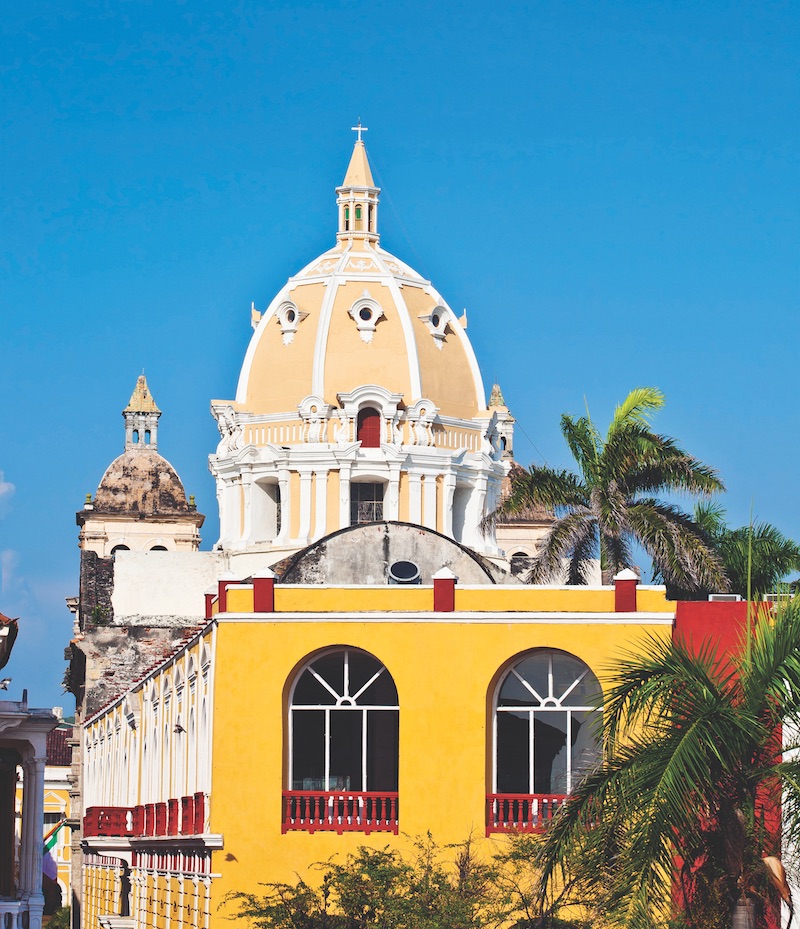
Painting a picture of Cartagena requires an expansive palette of electric pastels. A streak of aqua signifies the Caribbean Sea lapping against the well-worn walls of this ancient port city. Various shades of purple and pink form the bougainvillea blooming from the balconies of seventeenth-century homes. An unusual yellow—think mustard with a hint of terracotta—graces monuments, churches, and a smattering of apartment buildings. Single-story shacks emboldened in blue. Friendly vendors selling a rainbow of exotic fruit. Peridot-hued parrots chirping an organic ode to the sunset. There are many contenders in the contest of most colorful Colombian city, but Cartagena outshines them all.
Located on Colombia’s northern coast, Cartagena is a mélange of European, South American, African, and Caribbean influences. The Spanish settled here in 1533 and it wasn’t long before this New World port became a target for opposing European powers and pirates alike. As a result, the Spanish built a series of fortifications, including the imposing Castillo San Felipe de Barajas and an 11-kilometer-long urban enclosure. In 1984, the city’s port, forts, and some monuments were named a Unesco World Heritage Site, preserving Cartagena’s cobblestone streets and Colonial-era structures for future generations.

Today, Cartagena infuses its historic setting with a cosmopolitan spirit. Take the Casa San Agustin (hotelcasasanagustin.com) for example. A Hamak Hotels property, it comprises three restored seventeenth-century homes connected by a shared courtyard and a central pool framed by a former aqueduct. The blend of old and new continues in the 30 suites and guestrooms, each outfitted with Colonial architectural details and area artifacts juxtaposed with more modern artisan items.
Casa San Agustin, which opened in 2013, abounds in welcoming communal spaces. Stop by the library for a daily coffee happy hour, or head to the hotel’s rooftop solarium for a panoramic view. Take note of the adjacent clock tower atop the University of Cartagena; it’s a good reference point for finding the Casa San Agustin should you get lost exploring this open-air museum of a city.
Visitors and residents flock to the hotel’s Alma Restaurant. The party begins at the bar, where cocktail masters throw flames and pour amber elixirs over a pyramid of martini glasses all in the name of a good show and an excellent tipple. In the kitchen, chef Heberto Eljach specializes in refined Colombian dishes, like his signature ceviche with fish, octopus, and shrimp tossed in spices and sour cream, topped with pork rinds, and served with roasted arepas.

When it comes to elite bars and restaurants, Alma is in good company. Just a few blocks away, sister restaurants Carmen and Moshi operate out of one ultra-chic venue but offer vastly different cuisines. Carmen (carmencartagena.com) brings a contemporary, often whimsical touch to local seafood. Dishes like the Duo de Cangrejo (crab cake paired with crispy crab claws) and La Playa (octopus, shrimp, and white fish ceviche dressed with citrus tiger’s milk and nestled along a bed of edible sand) perplex in concept but delight in flavor. Moshi (moshico.com.co) incorporates the same Colombian products into classic Asian dishes. Its interpretation of the Korean staple bibimbap is last meal–level good.
Quality libations are as valued as spectacular seafood here, and nothing beats Colombian coffee. Savor some of the best, and grab a bag or two to take home, at Café San Alberto (cafesanalberto.com), a single-estate producer based in Buenavista, Colombia. Ábaco Libros y Café (abacolibros.com) perfects the coffee-and-book combination in a cozy setting packed with works by Spanish authors. Waste away the afternoon with a good book (one by Colombia native Gabriel García Márquez seems apropos) and a no-fuss frappuccino.
For something stronger, venture to El Barón Café & Liquor (elbaron.co) for a rum tasting hosted in Plaza San Pedro Claver. Many Colombian distilleries have cropped up recently, specializing in craft versions of this quintessential Caribbean spirit. Before diving into five samples—some aged for up to 20 years—guests sip on one of El Barón’s creative cocktails as they learn the history, science, and flavors of rum. The setting here is just as intoxicating as the liquor. A coral-stone cathedral chimes the time as the evening sun wanes, casting rays of magenta onto the plaza. It’s a magical scene, buzz or no buzz.
The most authentic way to soak in the sights, sounds, and tastes of Cartagena’s city life is by walking the streets with a native. Galavanta Colombia Tailored Travel (galavanta.com) can arrange an array of custom experiences, such as the El Barón rum tasting or a private tour of Old Town.

The morning of your tour, one of Galavanta’s expert guides will escort you to Castillo San Felipe de Barajas, where the most adventurous among you will embark upon a dark, humid trip through the fort’s labyrinth of tunnels. Then, you’ll cross over into Getsemaní, Old Town’s artistic hub where gorgeous graffiti abounds. Continue to Parque del Centenario and search for furry friends like sloths and pint-sized monkeys.
Just beyond the park sits a clock tower that acts as the main entryway into the completely enclosed Centro district. Many attractions are concentrated in this area. Pick up some sweets at el Portal de los Dulces. Peruse pieces by Colombia’s top artists, from Enrique Grau to Miguel Ángel Rojas, at the Museum of Modern Art Cartagena. Discover the mystical uses and practical applications of gold within the indigenous cultures of the Caribbean plains at the Museo del Oro Zenú. Or, find serenity at the Cartagena Cathedral, a circa-1612 Episcopal church that is the jewel of Cartagena’s skyline.
No matter which direction you go, be sure to follow your guide’s lead on street food. If he hands you an unidentified fruit and says, “Trust me,” you’ll do well to heed that advice. There’s also the ubiquitous limonada de coco, a frozen concoction to counteract Cartagena’s high temps. But to really beat the heat, reach for a homemade ice pop, known as boli. Colombian kids grow up on these things, and vendors stock coolers full of them, in flavors like coconut, tamarind, and even avocado. Nothing makes you feel like a local faster than people watching from a park bench as ice cream drips down your face. Trust us.









Facebook Comments